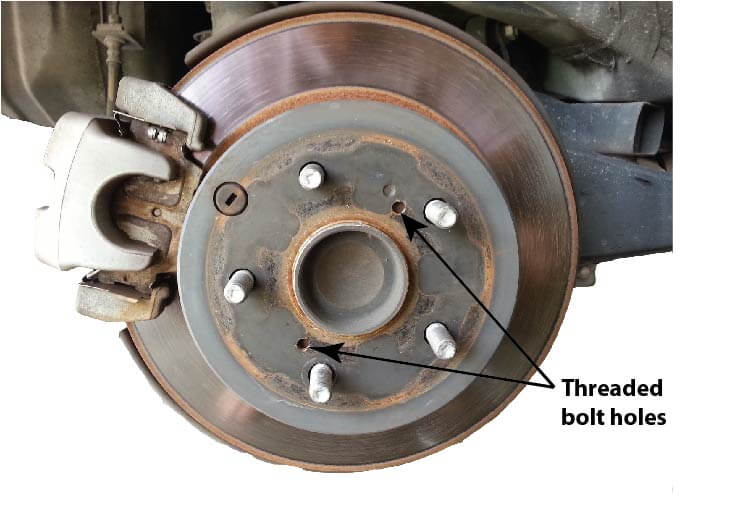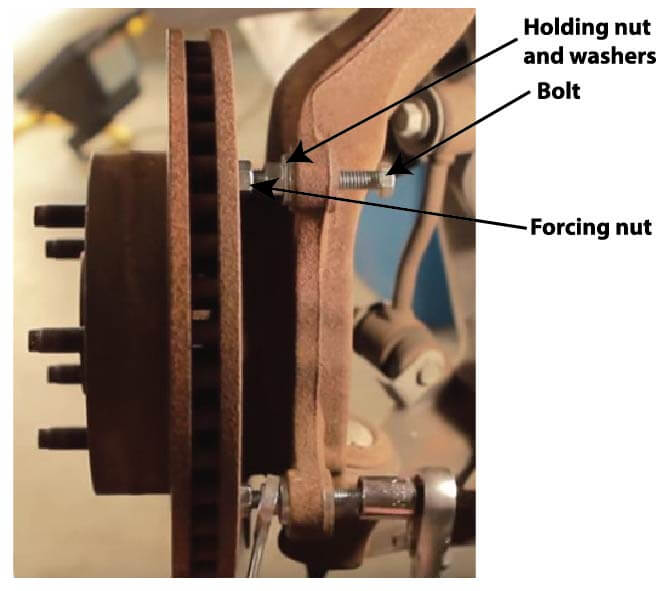Remove stuck brake rotor
How to remove a stuck brake rotor
Removing a stuck brake rotor can be a challenging task, especially if it has been on the vehicle for a long time. Rust, debris, and heat can cause the rotor to bond with the hub, making it difficult to remove. However, with the right tools and techniques, you can successfully remove a stuck brake rotor. This guide will walk you through the step-by-step process. If you’re doing a brake job and can’t remove a stuck rotor, follow these removal tips
Use the threaded holes and two bolts to force the rotor off the hub
Many car makers install rotors with threaded holes located in the  rotor “hat.” They serve no other purpose but to help during rotor removal.
rotor “hat.” They serve no other purpose but to help during rotor removal.
These holes often use a metric thread, so you’ll need metric bolts. Here’s how to proceed with the removal.
1) Shoot rust penetrant (Liquid Wrench, PB Blaster, etc ) between the studs and the rotor. Rotate the rotor 180° and repeat until the rust penetrant is dripping off the bottom of the rotor. Tap around the rotor hat with a hammer to set up vibrations to work the rust penetrant in deeper.
2) Insert bolts into the threaded holes in the rotor and tightly just slightly. Do NOT crank down on the bolts, or you’ll strip the threads. Then, with slight pressure from the bolts pushing against the wheel hub, smack the rotor face around its outer edge. Do this several times, then tighten the bolts ¼ turn and repeat. Continue smacking and tightening until the rotor breaks loose. Apply more rust penetrant while you’re doing this. This technique always works as long as you don’t try to over-tighten the bolts.
If the rotor doesn’t have threaded holes

Install a bolt through the caliper bracket and turn it to apply force to the inboard side of the brake rotor
In this case, you’ll use the brake caliper bracket holes to remove the rotor. Remove the brake caliper and then the bracket. Use a large long bolt, washers, and two nuts. Install the bolts, washers, and nuts as shown in this photo. Hold the inner nut with an open-end wrench and tighten the bolt so it presses against the rotor face. You just want to apply slight pressure to the rotor—don’t overtighten. Apply rust penetrant between the studs and rotor hat just as listed above. You want to saturate the area between the rotor hat and the wheel hub. Then, with slight pressure pushing the rotor away from the wheel hub, smack the rotor face with a hammer. The goal here is for the hammer blows to set up enough vibration to break the rust bond between the rotor and hub. You’re NOT trying to force the rotor off the hub with the bolt pressure.
Clean the hub
Once the rotor is off, make sure you clean all the rust off the wheel hub. If you don’t, you’ll get lateral runout, which causes disc thickness variation and brake pedal pulsation.
©, 2016 Rick Muscoplat
Posted on by Rick Muscoplat